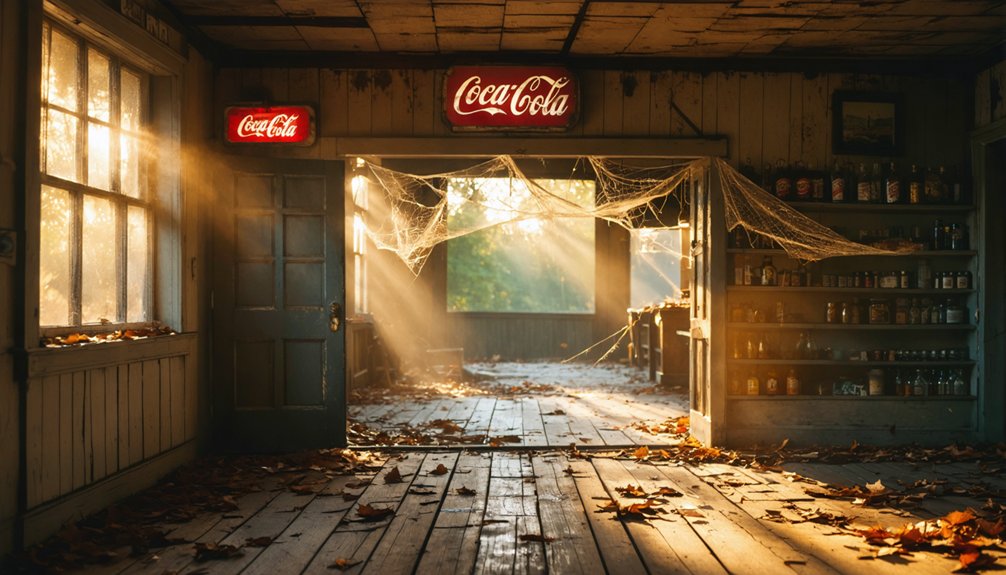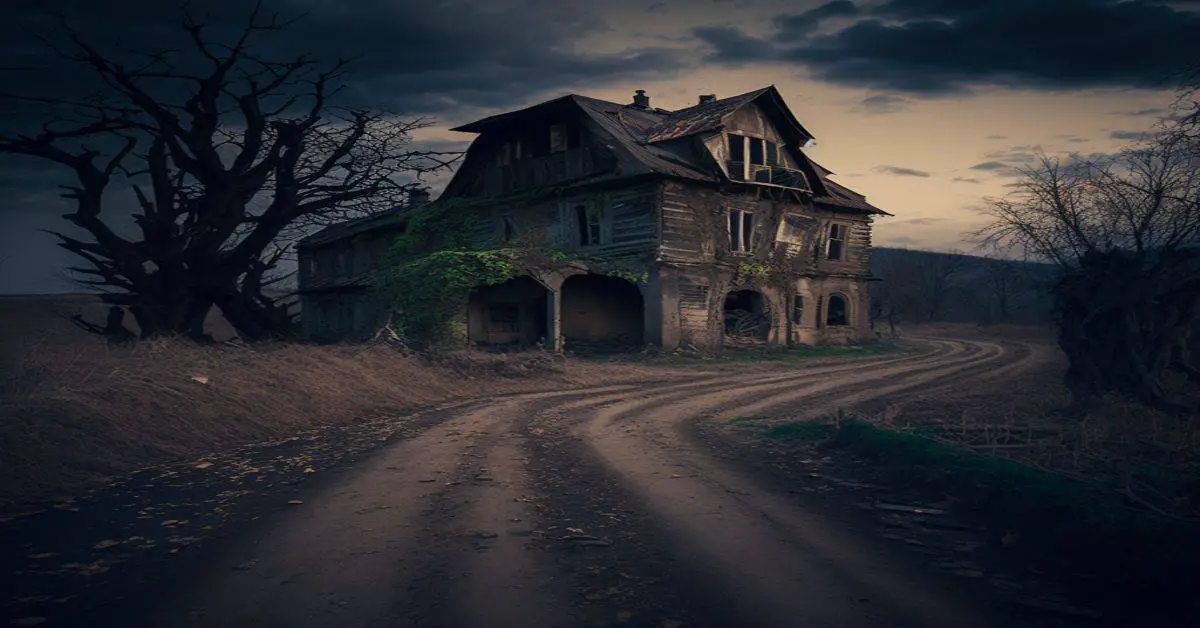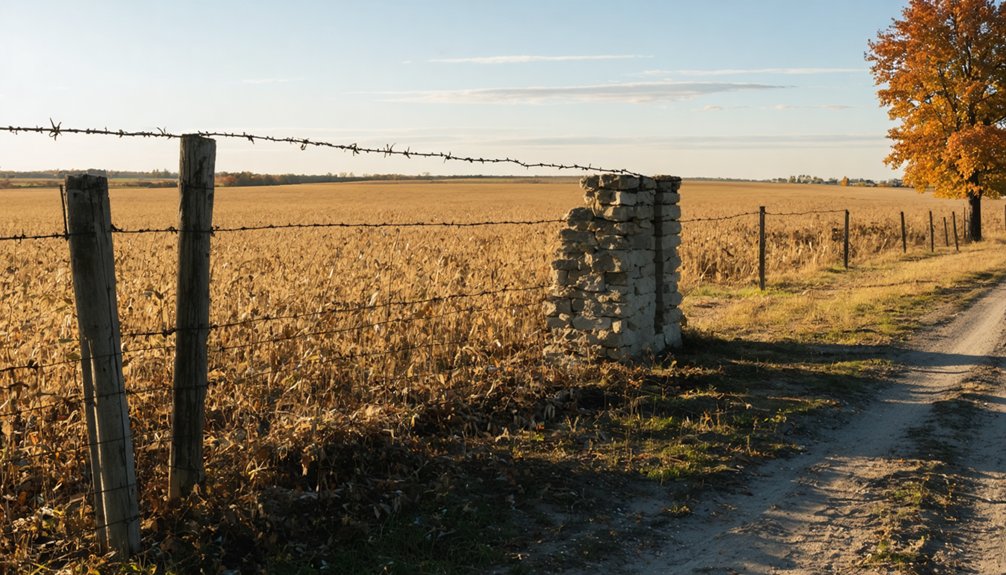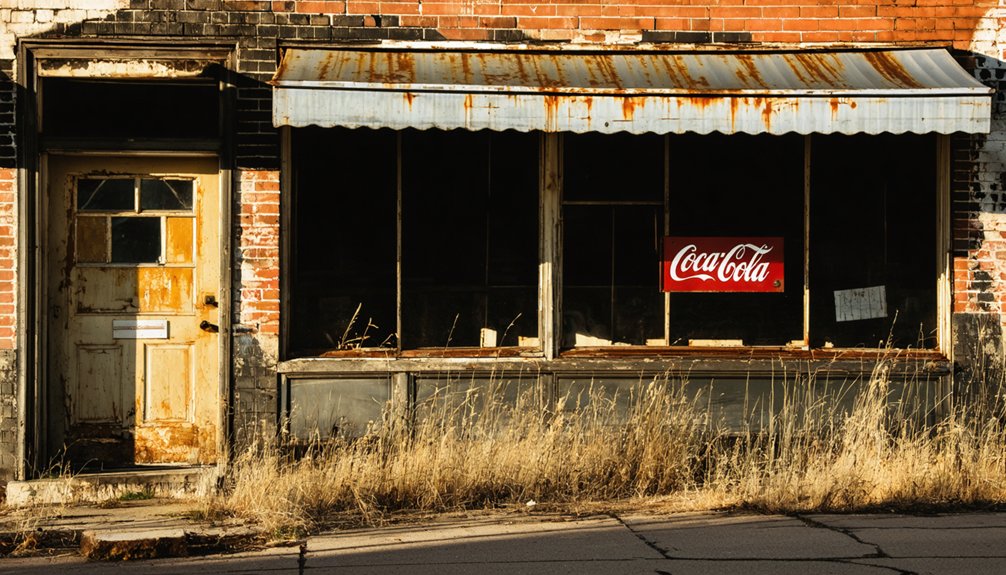You’ll discover Greenridge Mining Community two miles north-northeast of Nilwood in Macoupin County, Illinois. This once-thriving coal town peaked at 300 residents before its decline in 1923. The Illinois Central Railroad played an essential role in the community’s success, with superior coal operations employing over 1,100 workers in its heyday. Today, weathered architecture and abandoned structures tell stories of immigrant miners, bustling commercial districts, and the profound impact of Illinois’s coal mining heritage.
Key Takeaways
- Greenridge Mining Community, located near Nilwood in Macoupin County, reached a peak population of 300 before declining after 1923.
- The ghost town’s development was closely tied to the Illinois Central Railroad, which facilitated coal transport and community growth.
- Mining operations employed diverse immigrant workers from Scotland, Wales, England, and Ireland, shaping the town’s cultural identity.
- Abandoned structures, including the old schoolhouse with original furnishings, remain as testament to the once-thriving mining community.
- The town’s decline began with the closure of mining operations in 1923, coupled with diminishing railroad service.
The Rise and Fall of Greenridge Mining Community
While many Illinois mining towns experienced cycles of boom and bust, Greenridge emerged as a distinctive coal mining settlement established by the Green Ridge Mining Company two miles north-northeast of Nilwood in Macoupin County.
You’ll find its strategic location alongside railroad lines proved essential for both coal transport and community growth, helping it reach a peak population of 300 residents. Mining operations in the area permanently ceased in late 1923, causing a rapid decline in the town’s population.
The town’s mining technology centered on deeper extraction methods typical of Macoupin County operations, drawing diverse immigrant workers to form its community demographics. By 1910, the area’s mines employed 150 working boys, reflecting the widespread practice of child labor in Illinois coal operations.
Daily Life in a Bustling Coal Town
Three distinct social spheres shaped daily life in Macoupin County’s bustling coal towns: the mines, the immigrant communities, and the commercial districts.
You’d find yourself among European immigrants from Scotland, Wales, England, and Ireland, who brought their mining expertise and rich cultural traditions to the region.
Life revolved around the mines, where over 1,100 workers at Superior Coal Company spent their days in deep-pit operations.
Deep beneath Macoupin County’s surface, Superior Coal’s 1,100 miners carved out their livelihoods in the dark underground chambers.
Community gatherings centered in places like Benld and Mount Olive, where churches and stores served as social hubs.
Miner families lived in tight-knit neighborhoods near the mines, with multiple generations working underground. Boys as young as 9 or 10 worked as mule drivers or trappers, their families often misrepresenting their ages to secure employment.
Despite challenging conditions and labor unrest, you’d experience a vibrant community life enriched by diverse cultures, railway connections, and growing commercial activity.
By 1910, the area had become a major coal producer with 22 operating mines throughout Macoupin County.
Railroad’s Role in Greenridge’s Development
As railroad expansion swept through Illinois in the late 1800s, Greenridge emerged as a prime example of how rail infrastructure could birth and sustain a mining community. Similar to the first train arrival celebration in Sterling that drew 3,000 attendees, Greenridge’s inaugural rail connection was met with great fanfare.
You’ll find that the Illinois Central Railroad‘s network proved crucial to Greenridge’s success, connecting the town’s coal operations to major markets and urban centers. Coal shipments were particularly important, as thirty-eight percent of the railroad’s freight weight consisted of coal cargo.
The railroad’s economic impact touched every aspect of life in Greenridge. It enabled the mining company to build organized worker housing and establish efficient coal transport systems.
You’d have seen how the rail lines served as lifelines, bringing in supplies and workers while shipping out valuable coal resources.
When rail service began declining in the 1920s, Greenridge couldn’t survive the disconnection from its crucial transportation artery, demonstrating just how deeply the town’s existence was intertwined with the railroad’s presence.
Architectural Remnants and Abandoned Structures
Today in Hagaman, you’ll find compelling evidence of its once-thriving community through deteriorating yet distinctive architectural remnants.
Located 4 miles southwest of Hettick, this ghost town’s remains are a testament to pioneer settlement in Illinois.
The town’s old schoolhouse stands as a remarkable example of historical preservation, with its original desks and chalkboards still intact, offering you a genuine glimpse into 19th-century education.
As you explore the ghost town’s landscape, you’ll discover abandoned homes and commercial buildings that tell stories of past residential and economic life.
The journal’s extensive collection of lost towns documentation provides detailed historical context for sites like Hagaman.
While nature steadily reclaims these structures through environmental impact, the crumbling sidewalks and roads still connect these historical pieces.
The blend of weathered architecture and encroaching vegetation creates a hauntingly beautiful scene, though you’ll need to exercise caution when exploring these deteriorating structures that now serve as both cultural artifacts and wildlife habitats.
Legacy of Illinois Coal Mining Heritage
While Hagaman’s story intertwines with broader regional history, the town’s legacy remains deeply rooted in Illinois’ rich coal mining heritage.
You’ll find echoes of a time when Illinois ranked among the nation’s top coal producers, with over 5.5 billion tons extracted by 1990. The state’s coal mining heritage reflects both triumph and tragedy – from the pioneering discoveries of Joliet and Marquette in 1673 to the hard-fought battles for worker safety that shaped national labor reforms. Miners faced grueling conditions working 8 to 10 hours daily in dim light and dusty air. Employment in the mines reached its peak during World War II with nearly 100,000 workers.
The industry’s impact on community resilience is evident in the cultural contributions of immigrant miners from Wales, England, Ireland, Germany, and Sweden who settled these areas.
Though many mines now lie abandoned, their influence persists through local museums and historical societies that preserve this essential chapter of Illinois history.
Frequently Asked Questions
Are There Any Documented Paranormal Activities in Greenridge’s Abandoned Buildings?
You won’t find officially documented ghost sightings in Greenridge’s haunted buildings. While local folklore mentions miners’ spirits, there’s no verified paranormal evidence from the abandoned structures in this former mining town.
What Happened to the Residents After They Left Greenridge?
Like hitting the reset button, you’d find most Greenridge residents didn’t move far – they scattered to nearby Illinois towns, seeking jobs while maintaining their tight-knit community bonds despite the dispersal.
Can Visitors Legally Explore the Remaining Structures of Greenridge Today?
You can’t legally explore Greenridge’s structures today without landowner permission, as exploration regulations prohibit trespassing on private property. For visitor safety and legal compliance, avoid unauthorized access.
Were There Any Major Mining Accidents During Greenridge’s Operational Years?
Yes – in a grim reminder of mining safety’s evolution, records show multiple deadly incidents, including a tragic accident just one hour after Greenridge’s founding and the deaths of Schultze and Arnoldi in accident reports.
Did Any Famous Historical Figures Ever Visit or Have Connections to Greenridge?
You won’t find records of any notable visitors or direct historical connections to Greenridge during its short existence from 1894-1919, though the broader region attracted labor leaders during mining strikes.
References
- https://www.americanhauntingsink.com/carlinville
- https://www.bumpinthenight.net/courthouse
- https://macoupin.illinoisgenweb.org/history/tunnels-carlinville.html
- https://drloihjournal.blogspot.com/2022/09/lost-towns-of-illinois-greenridge-illinois.html
- http://livinghistoryofillinois.com/pdf_files/History of Macoupin County
- https://collections.carli.illinois.edu/digital/collection/sie_brink/id/1589/
- https://en.wikipedia.org/wiki/List_of_ghost_towns_in_Illinois
- http://www.illinoislaborhistory.org/labor-history-articles/mine-union-radicalism-in-macoupin-and-montgomery-counties-il
- https://www.youtube.com/watch?v=dV1Q41xepBA
- http://towns-and-nature.blogspot.com/2023/05/macoupin-c-greenridge-il-union-fuel-6.html



